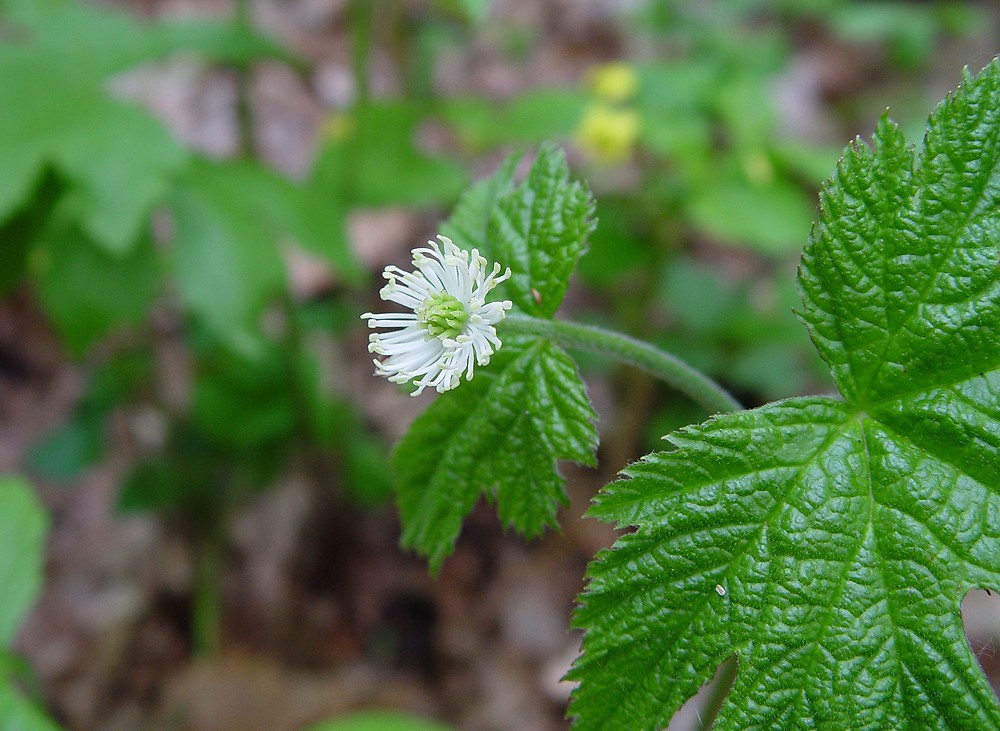Common Names: Orange Root, Yellow Root, Yellow Puccoon, Ground Raspberry, Indian Dye, Eye Root, Jaundice Root
Part Used: Root
Family: Ranunculaceae
Habitat & Distribution
Goldenseal is a perennial woodland herb native to southeastern Canada and the northeastern United States. It grows naturally in shaded, moist deciduous forests from Vermont to Georgia, extending westward to Alabama, Minnesota, Nebraska, and Arkansas. In Canada, it’s mostly found in Ontario. Once abundant in the Ohio Valley, populations declined due to deforestation and land development.
Description
A striking woodland perennial, Goldenseal grows from a bright yellow underground rhizome. In spring, a hairy stem rises 6 to 12 inches tall, bearing two large, wrinkled, palmately-lobed leaves with serrated edges and a rough texture. A small, solitary, greenish-white flower appears in April, lacking petals but boasting prominent stamens.
By July, the plant produces a raspberry-like cluster of bright red berries — although attractive, these are not edible.
Traditional Uses
Native American tribes extensively used Goldenseal as both a medicinal plant and natural dye. The Cherokee employed it to treat cancer, while others used it for eye inflammations and digestive complaints. In the 19th century, Eclectic physicians valued it for treating breast swellings, cancerous conditions (often paired with other herbs like Conium and Red Clover), and uterine disorders.
It was also a favored remedy for stomach ailments, chronic fevers, ulcers, liver congestion, menstrual problems, and mucosal infections.
Active Constituents & Pharmacology
Goldenseal contains several important isoquinoline alkaloids:
-
Berberine
-
Hydrastine
-
Berberastine
-
Hydrastinine
-
Canadine
-
Canalidine
Berberine is especially noted for its broad-spectrum antimicrobial effects against bacteria, fungi, protozoa, and chlamydia. While berberine alone has modest antibacterial action, whole Goldenseal preparations exhibit stronger clinical effects — potentially due to synergistic compounds that inhibit microbial drug resistance mechanisms.
Therapeutic Uses
Actions: Tonic, astringent, haemostatic, anti-inflammatory, anti-catarrhal, mild laxative, muscular stimulant, oxytocic, bitter, and alterative.
Internal Uses:
-
Stimulates appetite and digestion
-
Treats peptic ulcers, gastritis, dyspepsia, colitis, diarrhea, hemorrhoids, and chronic constipation
-
Supports upper respiratory conditions like catarrh and sore throats
-
Eases urinary tract inflammations
-
Controls excessive menstruation and postpartum hemorrhage
-
Stimulates uterine muscles (to be used cautiously and only under expert supervision)
External Uses:
-
Wash for skin ailments like eczema, ringworm, wounds, and poorly healing sores
-
Ear drops for earaches
-
Eye washes for conjunctivitis
-
Gargle for gum infections and sore throats
-
Vaginal douche for thrush and trichomoniasis
Caution
Goldenseal's potent uterine-stimulating action makes it unsuitable for unsupervised use during pregnancy. Always consult a qualified herbal practitioner before internal or external medicinal use.
Speech Disorder
A speech disorder, also known as a speech impairment...
ADHD
Attention-deficit / hyperactivity disorder (ADHD) is a...
Cerebral Palsy(CP)
Cerebral palsy (CP) is a group of neurological disorders...
Cancer
Cancer is a broad term for diseases where cells...




